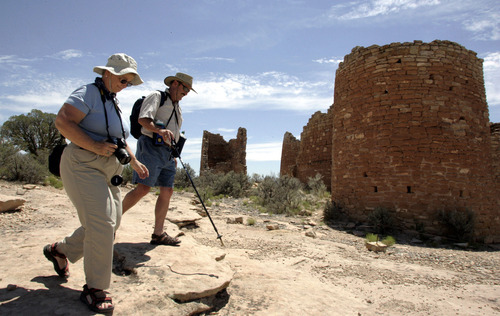This is an archived article that was published on sltrib.com in 2011, and information in the article may be outdated. It is provided only for personal research purposes and may not be reprinted.
Gov. Gary Herbert defended the firing of three state archaeologists Thursday, saying their dismissal was due solely to government downsizing and not controversial projects the archaeologists had been drawn into.
"The fact that these people were let go has nothing to do with anything they've ever done," Herbert said during a news conference at KUED. "It has to do with the direction we got from the Legislature and the budget cutting process."
House Speaker Becky Lockhart said that the Legislature made cuts to many departments, but it was left to the Governor's Office and the departments to decide how to implement the cuts.
"In terms of the exact way they decided to make the reduction, that was exclusively an executive branch decision," she said. "It was more along the lines of, 'OK, [the Department of] Community and Culture reductions have to be made, what is possible? Is there anything you've been looking at?' This was one of the suggestions."
State Archaeologist Kevin Jones, his deputy, Ronald Rood, and physical anthropologist Derinna Koop were laid off this week. The antiquities team repeatedly found itself in the midst of controversial issues, including the excavation of the Mountain Meadows Massacre site in southern Utah and plans to build a commuter-rail stop, stores and condos on the site of an American-Indian village in Draper.
Herbert said that, in the Draper instance, he "valued the counsel and advice we received from the archaeologists."
"In fact, their advice I followed and it helped me in putting together the conservation easement I signed into law there," said the governor, who signed an agreement to protect the archaeological site and build the station to the north. "It has nothing to do with that at all. It has only to do with the reduction-in-force because of budget cuts."
There was no specific mention in the list of cuts adopted by the Legislature of reductions to the archaeology staff or the funding for the office, although the department that houses the archaeologists did receive a budget cut.
Herbert said 1,000 state workers have lost their jobs in the past year and the archaeologists are just three among them. The governor said there are still archaeologists on staff with the Utah Department of Transportation, the Department of Natural Resources, one in the state history division and one in the Public Lands Policy Coordinating Office.
"This idea that somehow we're going to get away from having archaeologists help us in these important areas that are important to me and the state of Utah to preserve and understand is false," he said.
Forrest Cuch, who was terminated earlier this year as director of the Office of Indian Affairs, said he was convinced that the archaeologists were dismissed because of the Draper controversy, as he believes he was. New anthropology job posted
Utah's antiquities office is requiring its new "forensic scientist" — who will replace three archaeologists laid off in a controversial move this week — to have a state of Utah Archaeological Permit, and it will give preference to applicants with a minimum of a master's degree in physical or forensic anthropology, according to a listing on the "statejobs" Web page.
The new archaeology position was posted Wednesday, the day after state Archaeologist Kevin Jones and two assistants were laid off in what the Utah Department of Community and Culture called a cost-cutting measure.
Claudia Nakano, spokeswoman for the department, said the correct job listing, showing the educational requirements and professional credential, is posted at https://statejobs.utah.gov.
Another listing, on the Utah Department of Workforce Services Web page, indicates there are no educational requirements. But Nakano said that is "incorrect."
Judy Fahys





